Signing stained glass tells the world that you designed and made it ALL yourself. There’s something really satisfying about seeing your name on your window at the end of all your hard work.
It doesn’t have to be about your name – you could add a dedication, add part of a poem you love or copy a grandchild’s drawing for example.
It’s not as easy as adding a watermark on a photograph or signing a painting though; as usual with stained glass we need more creative solutions! I have explained a couple below.
Signing Stained Glass By Engraving
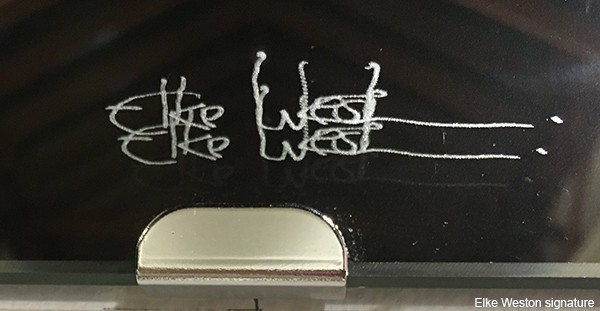
I like engraving as it’s subtle and allows you to put your individual mark on the piece. This lovely flamboyant signature was on a piece I saw at the Irish glass biennale by an artist called Elke Weston.
You can use a Dremel or similar drill to sign like this. If you’re thinking of getting one, the Dremel 4000 (paid link)has an option for connecting a flexible shaft which really helps for signing stained glass work.
A flexible shaft (paid link) is a wire coil which is very bendy. You fix one end to the Dremel and the other end has a tapered end which holds the drill bit.
Just so’s you know, if you click and buy through the link within 24 hrs I get a small % from Amazon, (not you!). Thanks in advance but no worries if you have a local store – I’d always support them first 🙂
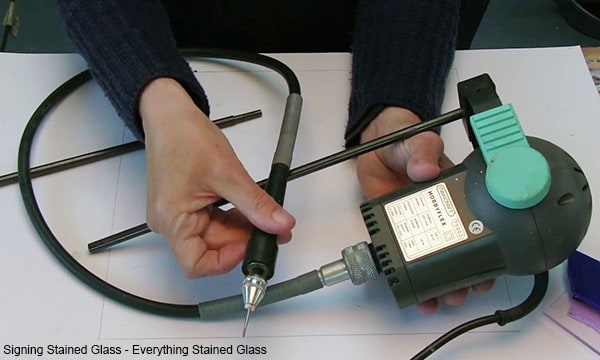
Here’s my flexible shaft set up – masquerading as a dentist’s drill! It means that I can hold the drill like a pencil and be more natural with my signature.
How To Sign Stained Glass Video
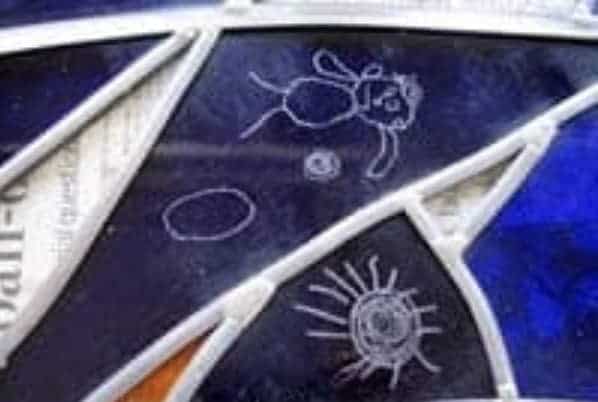 If you have no option but to engrave on lighter glass, you can always smear black permanent pen into your signature. It will help with visibility.
If you have no option but to engrave on lighter glass, you can always smear black permanent pen into your signature. It will help with visibility.
The exact same method can be used for any marks or drawings you want to make on your glass. If you wanted to copy a child’s drawing, you can copy it onto the glass with a white chinagraph pen and follow the lines with the drill bit.
Personalised Graduation Gift
This gorgeous example below is by an online student of mine, Deb Minez. She made it for her granddaughter’s graduation to celebrate her career-to-come as a writer and her photography skills.
She engraved the quote on the glass before assembly and used some of her favourite Fremont Antique Glass for the fountain pen. Can you see the “ink drops” of solder that Deb made and copper patina-ed so they would stand out a little. What a gem she has created here. A gift to treasure.
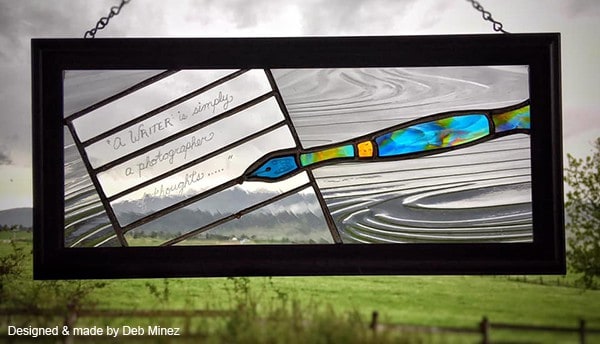
There are other ways to can sign your stained glass work. Embossing is another option.
Signing Your Stained Glass By Embossing
I remember loving these DYMO labellers (paid link) when I was a child, labelling everything in sight. Now I find – courtesy of my online student Stephanie Spurlock – that there’s another, grown up, glassy use for them!
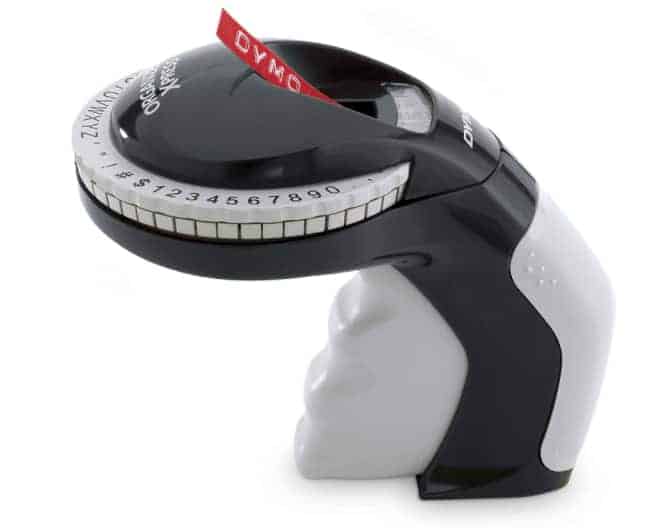
All you need to do is feed a strip of copper foil through the labeller instead of the supplied tape and punch out your name. It will emboss the foil with your name on.
This piece of copper foil can be soldered on the edge of your panel and finished off as normal. Just make sure it’s a very light tinning of solder; too much and your name (and fame!) will disappear.
My Embossing Experiment
In the absence of a labeller I thought I’d give it a try myself. I folded a piece of copper foil in half, sticky side together. I put this on a padded piece of lino so that I could press hard into it.
I used a horseshoe nail to spell out my name – anything pointed and metal will do – and then tinned over my name…
…it didn’t work!!!
For a start you have to write your name backwards so that your name stands proud in the copper foil, so my first attempts came out back to front LOL.
And secondly, my name is nearly impossible to read as I couldn’t easily write backwards and press hard at the same time:

Ah well, you get the gist and the experiment was fun 🙂 Best stick with the DYMO (paid link) if you fancy going down this embossing route.
One last thing; copyright. I’m sure you wouldn’t, but just a friendly warning – don’t go signing your stained glass work if it’s not 100% yours. Designed, made and everything… I don’t want you getting into trouble.
How are you signing stained glass or making patterns or marks? I’d love to hear your ideas below. Thanks 🙂
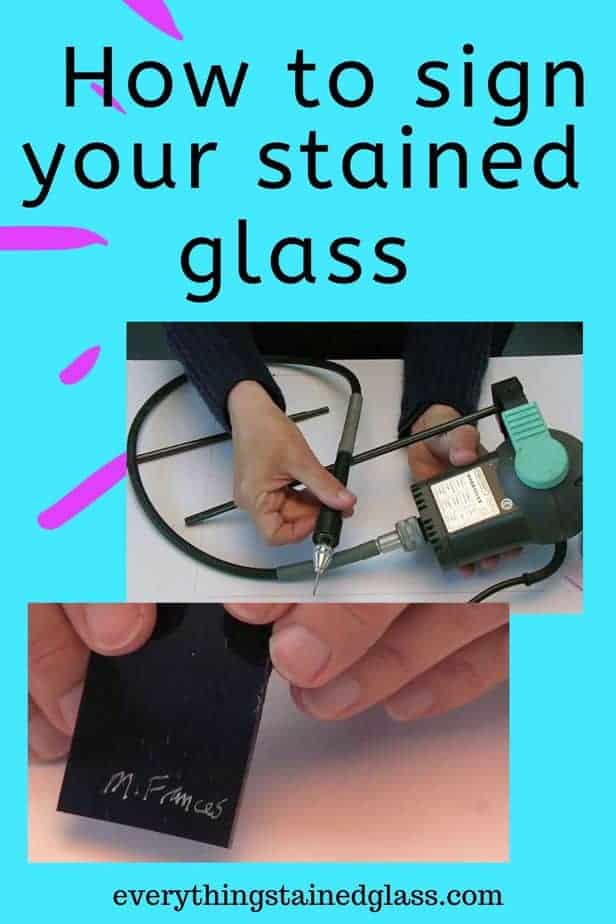
Related Resources
If you have a drill and want to drill holes go here
Etching cream is another way to make marks on your glass. You can find a whole set of tutorials on etching here.

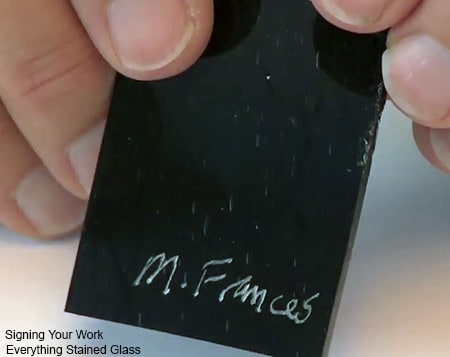
As always, thank you for sharing such brilliant tips and tricks. I occasionally use my dremel with a glass bit for fitting very small pieces, especially when they have sharp angles. But never thought about using it for signing. Can I just add too how comforting and relatable it was when you noted in the video that you spelled your name wrong? I aspire to create pieces with just a fraction of the beauty and precision of yours. But I often berate myself over glitches, goofs, miscalculations and the devastating “fat fingers” where I inadvertently drop and break the one piece for which I don’t have enough glass to replace in size, pattern, and/or color(s).
You didn’t just point out mispelling your name but you left it in the video instead of editing or cutting it out. For myself and any other creator out there who strives for the impossible standard of perfection at all costs. thank you so much. It was a bonus “tip” that mistakes happen but it’s such a small part of the whole project so continue on and let it go. Thanks again for this and all that you share with the stained glass community!
Oh this is such an interesting and humorous comment Joyce, thanks so much. I always say ‘fat fingered’ so that made me laugh. There would’ve been a time when I would have re-done the video because of that mistake but you’re right; I’ve come to realise it’s how we respond to mistakes, rather than the mistake itself, that’s the most important thing. Food for thought, thanks.
I have used a fine tip paint pen to sign. Nice because there are several colors available. It is not as durable as engraving. I have masked the signature and sprayed a light coat of lacquer over it to make it more permanent. I just thought of an idea, go over an engraved signature with the paint pen, then when dry, run a razor blade over it. Should leave a nice amount in the engraving. I’ll have to try that and see how it works.
I love your logic as you wrote this Bill, thanks for the idea. It sounds a good one.
Thanks Milly for sharing your tips to us, it really helps me a lot, i’m a beginner in Tiffany after years of glass Mosaic greetz from the Netherlands
You’re most welcome Conny, greetings back from Ireland 🙂
Milly
I want to order a Dremel 4000 with flexible shaft but need to know what diamond bit to buy to go onto the flexible shaft (preferably a bit that I can buy from Amazon (where I’ll get the Dremel).
Please send answer asap . Thank you.
Hi Joanna, I don’t know where you are in the world so I’m assuming US. If so, there are some here:
https://www.glasshousestore.com/product/1-2-mm-diamond-drill-bits/
Or in UK:
https://www.cooksongold.com/Jewellery-Tools/Diamond-Shank-Drill-0.8mm-prcode-999-CBW?p=gs&gclid=CjwKCAjwkYGVBhArEiwA4sZLuIp-UOPwac5yyyWPfZA5uR6_t0l4w1j-eZn9zLL-Kk24o7BvMovZyxoCUFEQAvD_BwE&gclsrc=aw.ds
Search for impregnated diamond drill bits jewellery.
I hope that helps.
I use this one
https://www.amazon.ca/-/fr/%C3%A9lectrique-rechargeable-pr%C3%A9cision-bricolage-c%C3%A9ramique/dp/B098Q855WD/ref=rvi_sccl_45/147-2520103-7254623?pd_rd_w=a67fX&content-id=amzn1.sym.8b4d8c20-8e51-4634-a76f-c00a1995a502&pf_rd_p=8b4d8c20-8e51-4634-a76f-c00a1995a502&pf_rd_r=C3VSWJMAPN305MM6VDVP&pd_rd_wg=kh1Uw&pd_rd_r=61513f92-f6b0-40a8-b1a1-fb8ad25df42c&pd_rd_i=B098Q855WD&psc=1
à
it is a pencil look dremmel type very easy to use like a pencil to sing;
also I put gold gilding stuff over my sing after driling or engraved it
but you have to put glue for glass ;after to be safe I put microscope preparation glass over my gilding sing it look perfect
Thanks for the link Jacques, that’s helpful.
I connect a flexible shaft through a sewing machine foot control
Set the motor (eg Drimmel) to max
Now the speed is controlled by the foot control
And the speed is infinitely variable
Also I use water when using any diamond tool on glass
Ingenious Tom. I have a foot pedal for mine too but bought it separately; never thought of ransacking a sewing machine! Yes, always use water, agreed 🙂
I just got a Dremel with a handheld part! Love to try this out. I Used to engrave in the past, by hand. I still have these tools, so I usually put my initials on a piece that is 100 % mine.
I think you’ll find the flexible shaft a great help Berna. Good luck!
Hi Milly. I really enjoy your frequent on-line tricks and tutorials. I just do stained glass as a hobby but occasionally make something that I like to sign. I use thin copper wire and shape it in the image of my initials. Then I soldier it to the lead or zinc frame on the lower right edge of my panel. I can’t paste a picture here but would be happy to send a picture if you give me an email to respond to. Thanks for your continued support of the stained glass community.
ooh yes please Neal, what a good idea. I’d like to add that to this page. If you like more tips you could sign up to my newsletter here and then you’ll have my email.
If not, my Contact form is here for exchange of emails: https://everythingstainedglass.com/contact
Apologies for not giving it out here but spam bots are vicious!
Love your tips, Really helps , I apply your tips when I run into any problems, THANK YOU FOR ALL YOUR TIPS
Aw, you’re welcome Daniel, I’m so glad they help 🙂
Milly, Great tips as usual. I sign my pieces using a Dremel tool. But I never knew the speed of the bit had so much influence on how it comes out. I’ll have to check it out next time I sign a piece. THANKS!
It’s surprising; when I started I thought it was best to go slower but soon found differently. I hope being speedy makes for neater signatures (hopefully spelt correctly LOL)
Hi Milly, I use an etching pen/scriber available at a stained glass store in Denver, Colorado. The brand is “General”. It works pretty well if you print vs writing cursive. I sign the back on a piece of glass near the bottom of the frame. It doesn’t show through to the front.
Ah, you go for the modest version Becky; signing on the back. That’s another good option as it doesn’t detract or distract from the image.
Thanks for your addition, much appreciated 🙂
I discovered you before I was scheduled for cataract surgery so I’ve been getting your newsletter and saving it on my computer so when I can see again, I can try some of your tutorials. I think you are a wonderful teacher and I am enthusiastic about learning more about creating some lovely stained glass pieces. I’ve taken only one short class years ago and I made a small window that turned out fairly well and I’ve made some simple Christmas ornaments to give friends and family as stocking stuffers, but soon I’ll be ready for more.
I just wanted to compliment you on your talent both as an artist and as a teacher. I look forward to being able to see clearly soon, and study your tutorials.
That’s such a lovely comment to read Coco, thank you. Recover soon and get back to stained glass quickly. ‘See’ you then, as you will too 🙂
Hi Milly
Nice tip (pun intended)
I am using a deremel tool to engrave and drill holes in glass. I use diamond bits which I buy at dentists supply depo.They are not expensive come in veriaty of sizes and I use them to drill in glass as well as engraving.
That’s a good option for sourcing the diamond bits Micky, thanks for sharing!
Yes, this set up is great for drilling holes too. If anyone prefers to drill larger holes with a grinder bit, I have a page that covers that.
Hey Milly
I haven’t started signing my stained glass projects yet, so I have a question.
I’ve seen a panel I really liked and made one sorta like it. You could say I re-designed/modified it so it wasn’t exactly the same. Would this be considered my design now?
Thanks for any clarification on this subject you can supply would be greatly appreciated.
Also, thanks for all your tips and courses you provide.
Good question Karen. The copyright issue is a thorny one Karen. Only you can make the decision as to whether you’ve made the piece sufficiently ‘yours’ with changes to warrant signing your name on it. If you haven’t I wouldn’t risk it.
Glad you find my tips and online classes helpful 🙂
I sign my work by engraving but learned the hard way to not do this on a whole finished piece as I had the corner piece where I signed crack. I now sign just the piece then install it, this has saved me lots of grief. Love all your tips, have been glassing for over 20 yrs. Suzy in Wis.
Good point, well made Suzy in Wis! How heartbreaking it is when we break something right at the finish. Thanks for adding this and glad you like the tips. It’s becoming a kind of joint effort with my lovely readers adding so much value too 🙂
I do try to sign my work . Nothing fancy , just my initials . My husband found a battery operated small drill a bit like a fat pencil , while he was browsing in a well known cheapie store ,( not the furniture one ) it works fine , quite a bit of vibration but it does the job .
Stay “ Aleart “ but keep glassing !
Barbara M.
I know the type you mean Barbara, thanks for suggesting it as a (cheaper) option for people. Initials are classy I think; essence of you 🙂
When I only have light glass, or clear to sign my name, I usually engrave my initials or name and then rub a black permanent marker over it and wipe the marker off, leaving the lightly etched letters with a black coloring on them. Not bright black, but at least readable.
A perfect addition to the page, thanks Deborah. How did I forget this, sigh! I’ll add it to the page above too, to make sure people see it.
If I’m doing a painted piece I rub some of the black pigment into my signature and fire it in permanently.